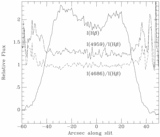The Planetary Nebula A39: An Observational Benchmark for Numerical Modeling of Photoionized Plasmas
Abstract
Galactic nebulae are the main probes for the chemical evolution of the interstellar medium. Yet, recent observations have shown that chemical abundances determined from recombination and collisionally excited emission lines can differ by as much as an order of magnitude in some planetary nebulae (PNs). Many PNs have complex geometries and morphological evidence for interactions from stellar winds, and it is not clear to what extent winds, inhomogeneities, or shocked gas affect the observed spectrum. There currently is no full explanation for this discrepancy, which brings into question whether we understand the physical state of these low-density plasmas at all. This paper presents new spectroscopy from the KPNO Mayall 4 m telescope and imagery from the WIYN 3.5 m telescope of A39, a large PN with an exceptionally simple geometry. It appears to be a limb-brightened spherical shell, the simplest possible nebula. There is little evidence for external interactions, so this is the case in which photoionization simulations should be in near-perfect agreement with observation. We combine optical and UV spectroscopy to form a composite spectrum and compare this with photoionization models. No problems were encountered in reproducing the observed spectrum, although even this simple object has two distinct emission-line regions and exhibits several anomalies. A39 was too faint to detect the crucial heavy-element recombination lines in our data set, so it was not possible to compare collisional and recombination abundances. We predict the spectrum over a broad range of bandpasses to facilitate future observations that may probe deeper than our instrumentation allowed.
- Publication:
-
The Astrophysical Journal
- Pub Date:
- October 2001
- DOI:
- 10.1086/322489
- Bibcode:
- 2001ApJ...560..272J
- Keywords:
-
- ISM: Abundances;
- ISM: Planetary Nebulae: General;
- ISM: Planetary Nebulae: Individual: Name: Abell 39
